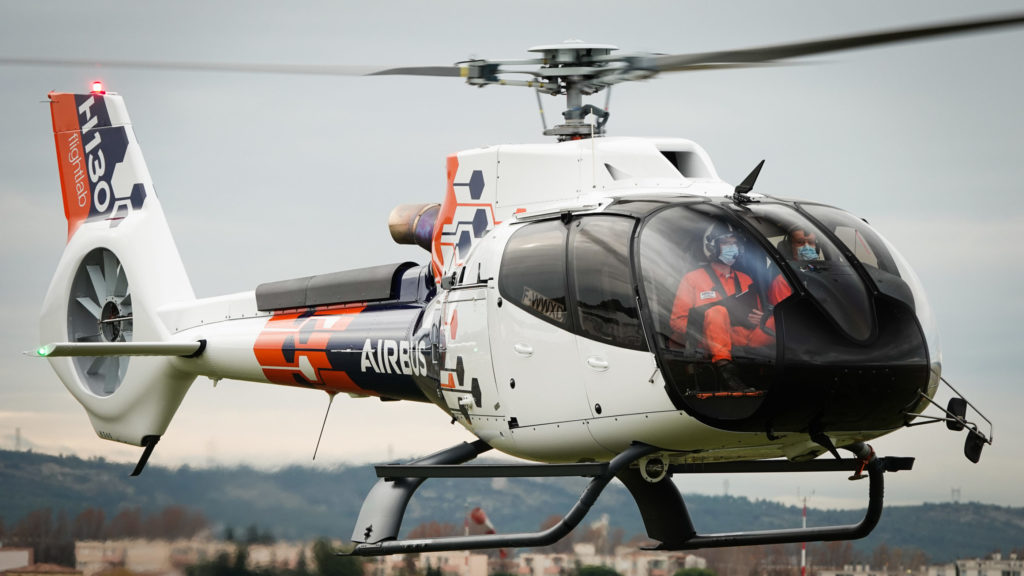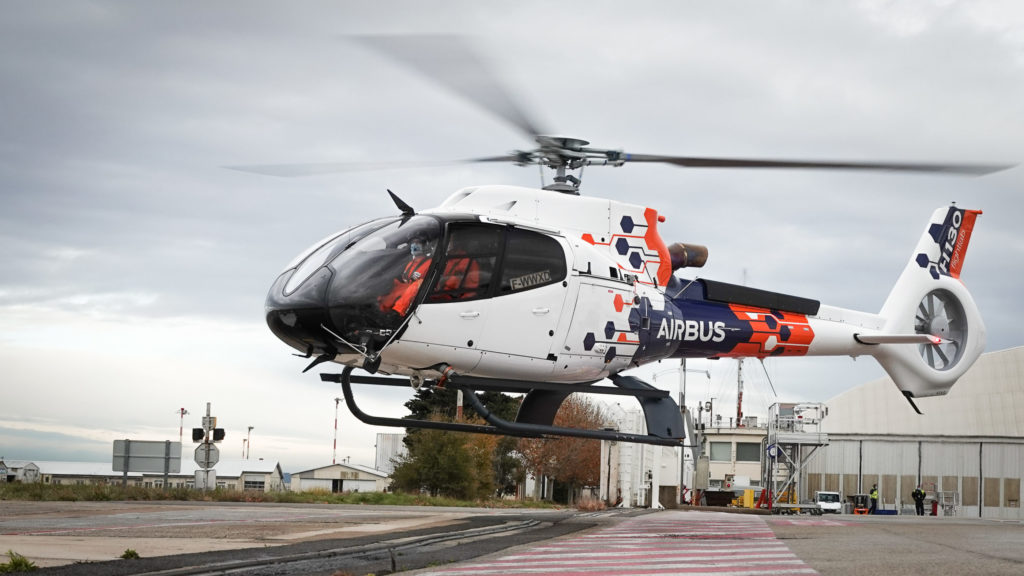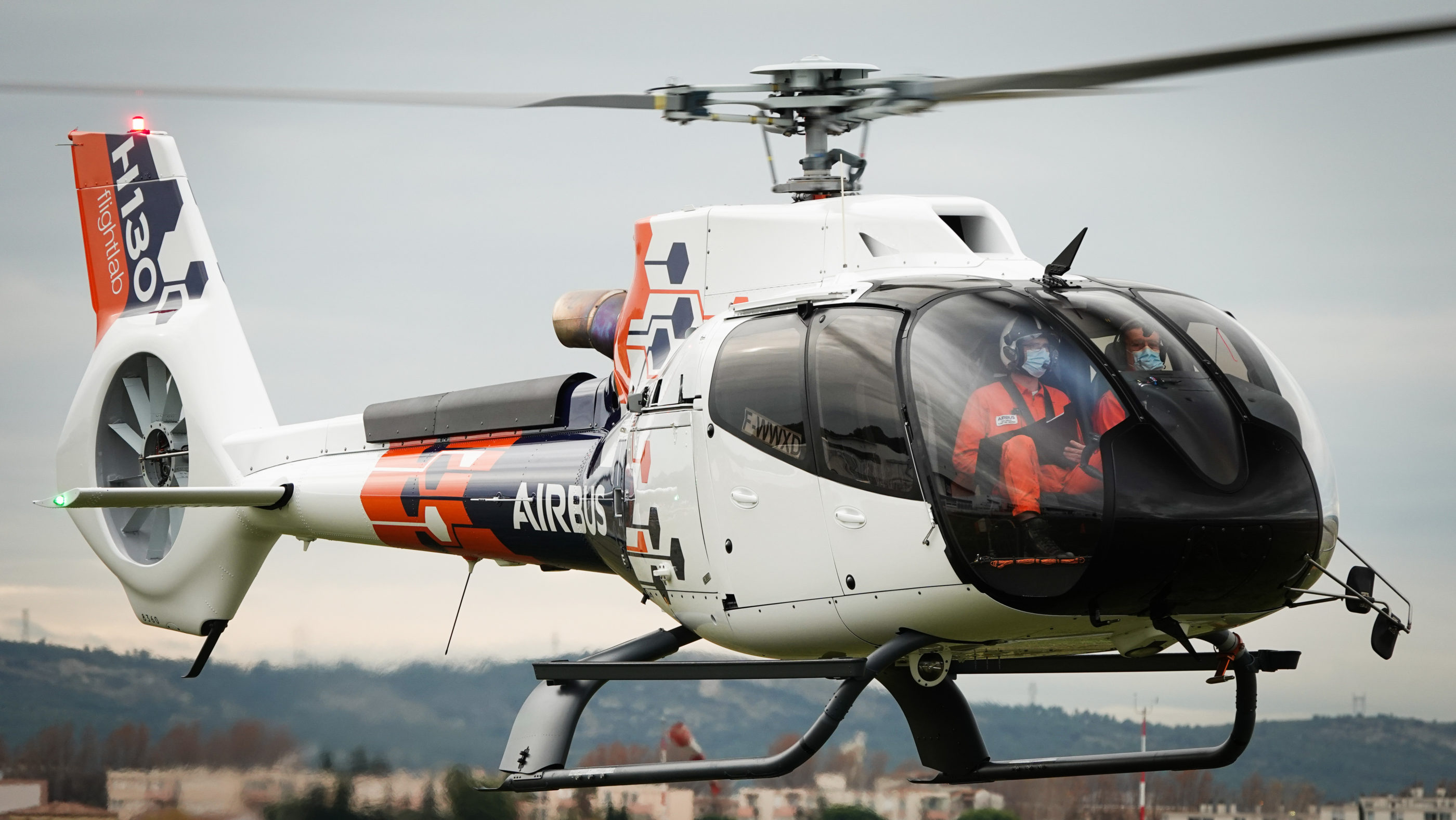Airbus Helicopters has revealed it is using a modified H130 to quickly mature platform-agnostic technology that could be used across the wider Airbus group’s fleet, including new flight controls, visual detection capabilities and hybrid propulsion.

The manufacturer began tests using the Flightlab “flying laboratory” last April, and the first technology “bricks” matured using the helicopter could be available to consumers as early as mid-2021, according to Tomasz Krysinski, head of research and innovation at Airbus Helicopters.
The Flightlab program is a collaborative effort, including engineers from Airbus Commercial and Airbus Defence and Space. The various technology bricks are matured separately on test benches before a core team of five or six engineers integrates them into the Flightlab aircraft.
“The integration . . . is the heart of the Flightlab,” Alexandre Gyerczynski, Flightlab project leader, told reporters during a conference call. “To install the systems which we want to test faster, at less cost, in an agile way.”
This approach will bring some of these technologies to market two or three times faster than conventional development methods, added Krysinski.
The first to hit the market will be a rotor strike alerting system (RSAS), which uses two lidar sensors – one on either side of the aircraft – to detect obstacles near to the main or tail rotor, much like a parking sensor on a car. And, in a similar vein, this information is presented to the pilot on a cockpit display that illustrates where the obstacle is located, with its proximity shown by a green, orange, or red light in the display.
“This system will be able to work in the rain, dust and snow conditions, which are more difficult situations for the pilot,” said Gyerczynski.
Airbus began testing the RSAS in December 2020, and expects to bring it to the market in the middle of this year. “It will start from the smallest platform,” said Krysinski, indicating the ubiquitous H125/AS350.
The RSAS system is just one of several technologies the manufacturer is developing and/or maturing on the Flightlab aircraft that aim to enhance autonomy and safety. The others include an image detection system known as EAGLE (eye for autonomous guidance and landing extension), an enhanced health and usage monitoring system (HUMS), and urban air mobility flight controls.
The EAGLE system utilizes a gyro-stabilized camera to analyze an aircraft’s environment, and interprets this using algorithms “to detect areas which are interesting or dangerous for the aircraft,” said Gyerczynski. “In the future, [the aircraft] will use this algorithm together with the automatic pilot.”
Airbus autonomy expert Nicolas Damiani said the long-term goal for the EAGLE system is full autonomy, but that the manufacturer would employ a “step-by-step” approach to reaching it, with the level of automation progressively increased.
The manufacturer demonstrated the ability to acquire a helipad using a camera, and automate the approach and landing, at the end of 2019.
“Here, the intention is to not only do that with the camera, not only to do that for the approach and landing, but to cover, step by step, all the flight phases,” said Damiani.
The idea is to let the pilot decide how much of the flight is automated, leaving them free to monitor systems and make “high level” decisions.

In terms of the flight controls, Damiani described them as employing a “hybrid architecture,” rather than being full fly-by-wire, allowing them to work with the H130’s conventional hydraulically actuated systems. Nonetheless, they are considered a “new approach to pilot/machine interface,” developed with the stated aim of reducing the pilot workload and increasing safety.
And while Airbus (and other third-party providers) already have HUMS systems available for their aircraft, the version in Flightlab will be lighter, more effective – and more intelligent, said Gyerczynski. The software will be capable of “pre-analyzing” the data it collects before sending it out and provide operators the ability to balance their main and tail rotors directly on the aircraft, without the need for an external system.
Hybrid propulsion
The second key area of focus for the Flightlab program is the pursuit of hybrid and electric propulsion technologies. To begin with, a 100-kW electric motor will be connected to the main gearbox to provide emergency electric power in the event of an engine failure.
“When the turbine [engine] fails, the system will be switched on automatically,” said Luca Cossetti, an electrification and hybridisation expert. “The pilot will know that he has a reserve of energy, or power, for about 30 seconds, roughly. Ideally, the power is provided at the failure, so to avoid the rotor speed decaying too much, and at the flare, where the pilot will stop the helicopter and pull on the collective to push on landing the helicopter. In that case . . . the power needs to be available for five/10 seconds to really allow the flare.”
The electric motor would also improve the aircraft’s maximum takeoff weight, Cossetti said.
The target of increasing efficiency and reducing fuel consumption would be achieved in a second step, he said. A more powerful version of the electric system would be customized to provide additional power in some phases of the flight, much like a hybrid electric engine in a car.
“That evolution will bring some emission reduction, and also noise reduction, which is a significant part of the environmental reduction we want to achieve,” said Cossetti.

Flightlab began tests to measure and correlate the sound levels of helicopters as perceived by people on the ground last year, using noise sensors installed around Airbus Helicopters’ headquarters in Marignane, France.
“This measurement is . . . helping our acoustic experts to develop models of how the noise is amplified or reduced due to the buildings’ and the streets’ configuration,” said Gyerczynski.
The models will be used to help guide further refinement on helicopters to reduce noise generation, as well as to guide aviation authorities as they consider regulations related to urban air mobility.
The H130 was selected as the Flightlab platform due to its small size, said Gyerczynski. As well as reducing the cost of flight tests, a small platform “forces the designers to design light and at best cost,” he said.
Krysinski said the arrival of the type of technologies incorporated in Flightlab was part of a “third revolution” in aviation, allowing helicopters to become lighter, reduce consumption, and make them quieter.
“All these converging technologies we’ll bring on the market in this decade are really very interesting disruptive concepts, and will really bring value to the customers,” he said.
Airbus plans to continue flight tests using Flightlab into 2024.









